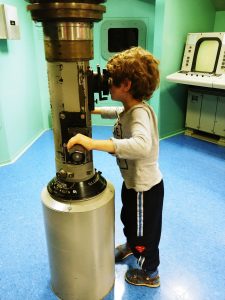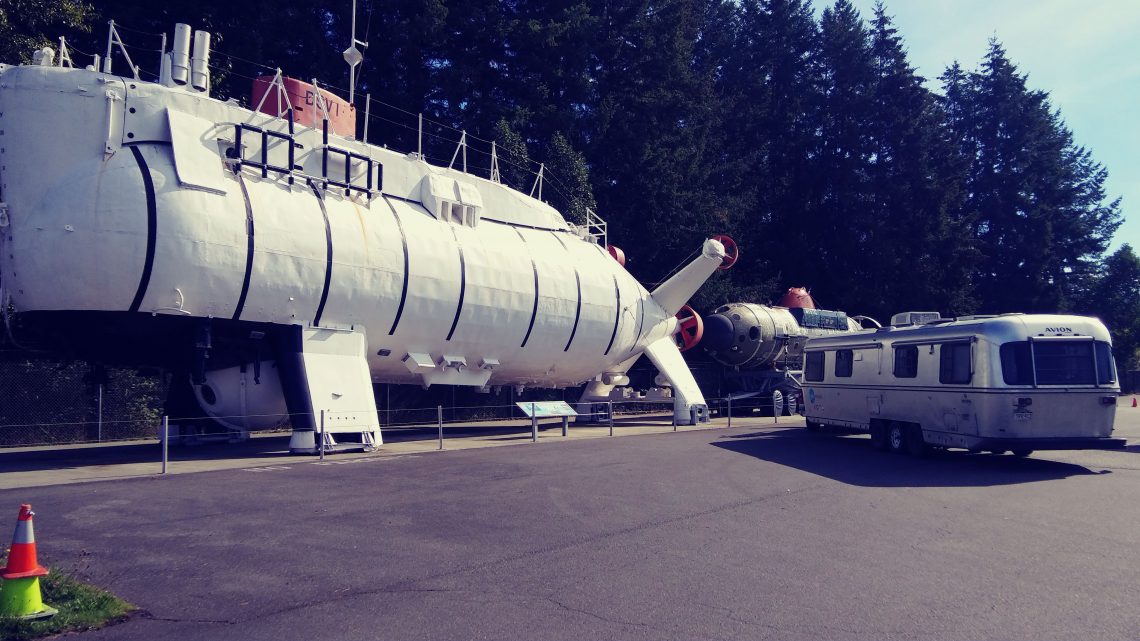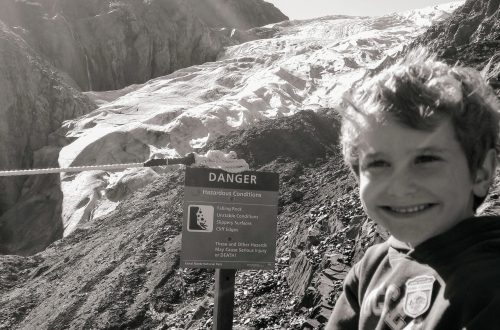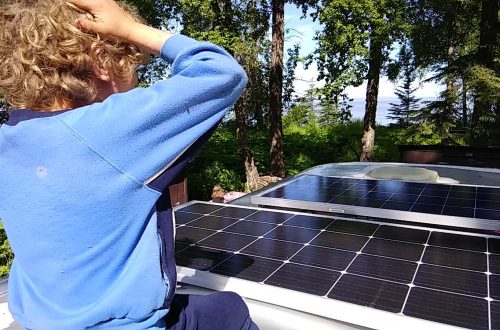On our way to the Olympic National Park in Washington, we make a last-minute decision to visit the Naval Undersea Museum and manage to make a U-turn while towing the Avion. When we get to Keyport, the museum turns out to be on a naval base. We arrive after closing time and have not decided yet on where to sleep. The parking lot of the museum is pretty big and Antoine and Finn walk over to the heavily armed guards of the base to ask if we may spend the night here. I am hugely surprised when they tell me that the guards responded with a simple “why not” and I start making dinner.
It is always fun to sleep in unusual places. On our bike trips before we had kids, we did this all the time. We slept in fire stations, on a helicopter pad (unintentionally), golf courses, soccer fields and on a particularly windy day inside a bathroom (a personal low I must admit). While cooking we overhear the ceremonial lowering of the flag, and in the morning we enjoy the National Anthem at sunrise. After chores, we head to the museum. It turns out that we are parked right next to two large underwater vehicles; one that was used for rescue missions and one that was the first deep submergence vehicle built by the US Navy, with the ability to go down to 20,000 feet. Our trailer is minuscule compared to these giants.
Finn and Metta don’t have enough patience to go through the entire exhibition on the history of submarine development, but Zoe does not want to skip a single sign. We go from breath holding techniques, via the different materials used to create diving instruments to modern technology. A bit further into our exploration of the naval undersea museum, we see missiles in all sizes. These deadly machines are interesting to see from close by, but they make Zoe very nervous, especially when Metta reaches out to touch one.
Inside a submarine
 Antoine leads us through a random door of a submarine (these are small, much more kids’ size than suitable for adults), around the corner and into the navigation room of a rebuilt partial submarine. We look through the periscope and can see our Avion in the parking lot. There are sounds and voices recorded on a real submarine, and the kids wonder if we could take off any time while they sit in the captain’s seat.
Antoine leads us through a random door of a submarine (these are small, much more kids’ size than suitable for adults), around the corner and into the navigation room of a rebuilt partial submarine. We look through the periscope and can see our Avion in the parking lot. There are sounds and voices recorded on a real submarine, and the kids wonder if we could take off any time while they sit in the captain’s seat.
Another display shows facts about water. There is a great visual on how our water cycle works and we learn about pressure. At this point we have completely lost our toddler’s attention though. On to the next room, with a fabulous display about safety. Don’t we all wonder about the dangers of being trapped under water and how one would escape? We learn about how marines train in a large silo to come up gradually, using just their lungs. Even though modern technology offers suits that even turn into life rafts as well as allowing to come back to the surface of the water without pressure damage, everyone still has to be trained to rely on their own body. I find it a fascinating world.
Dolphins
When we are ready to head out, I notice a sign about the Navy Dolphins. At first I assume it’s just another department named ‘Dolphins’, but then I realize that the navy uses actual dolphins for military missions. The animals are trained for years and capable of retrieving items and much more. I had no idea. Did you know about this?
The Naval Undersea Museum has surprisingly much to offer, and it is completely free. It may not be so interesting for toddlers, but for the older children there is plenty to learn, to touch and to do.






2 Comments
Anna
I just saw you all in Susanville! Welcome!
earthnomads
Thank you Anna! We had a wonderful afternoon in the park. Looks like a nice town, but stay safe with the Campfire getting so close!